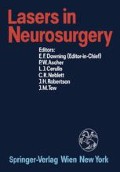Abstract
Recent technological improvements have resulted in the introduction of contact probes which have improved laser fiberoptic delivery system and substances able to transmit laser light. The sapphire tips introduced by Daikuzono and Joffe in 1985 [1] are currently used to deliver more than 90% of laser light, causing no tissue adhesion phenomena. This is an artificial crystal which is hard enough and has enough mechanical resistance to prevent breaking of the tip. Lateral irradiation, which results in 30–40% of the total power delivered in non-contact probes, is avoided, thus providing substantial reduction in laser energy requirements. The contact tips are so efficient that very low thermal energy is required for a sharp incision, because of such rapid tissue vaporization. The greater divergence of the beam limits the thermal effect, thereby minimizing the lesion. The contact probes are suitable for both freehand and endoscopic application.
Access this chapter
Tax calculation will be finalised at checkout
Purchases are for personal use only
Preview
Unable to display preview. Download preview PDF.
References
Daikuzono N, Joffe SN (1985) Sapphire probe for contact photocoagulation and tissue vaporization with the Nd: YAG laser. Medical Instrumentation 4: 173–178.
Diaz FG, Dujovny M, King PK, Chason J, Ausman JI, Malik G, Berman SK (1986) Use of the contact Nd: YAG laser scalpel in neurosurgery. Proceedings of the 4th general and scientific meeting of the LANSI (Laser Association of Neurological Surgeons International), Venice, in press.
Fasano VA, Peirone SM, Ponzio RM, Lanotte MM, Merighi A (1986) Effect at the periphery of the laser lesion in human brain and its tumors after CO2, Nd: YAG and CO2 high peak pulsed radiation. Lasers Surg Med 3: 308–317.
Karnowsky MJ (1965): A formaldehyde-glutaraldehyde fixative of high osmolarity for use in electron microscopy. J Cell Biol 27: 137A–138A.
Jain KK (1985) Complications of the use of the Nd: YAG laser in neurosurgery. Neurosurgery 16: 759–762.
Author information
Authors and Affiliations
Editor information
Editors and Affiliations
Rights and permissions
Copyright information
© 1989 Springer-Verlag/Wien
About this chapter
Cite this chapter
Fasano, V.A., Ponzio, R.M. (1989). The Use of Contact Laser in Neurosurgery. Clinical and Experimental Data. In: Downing, E.F., Ascher, P.W., Cerullo, L.J., Neblett, C.R., Robertson, J.H., Tew, J.M. (eds) Lasers in Neurosurgery. Springer, Vienna. https://doi.org/10.1007/978-3-7091-7607-8_7
Download citation
DOI: https://doi.org/10.1007/978-3-7091-7607-8_7
Publisher Name: Springer, Vienna
Print ISBN: 978-3-211-82067-4
Online ISBN: 978-3-7091-7607-8
eBook Packages: Springer Book Archive

